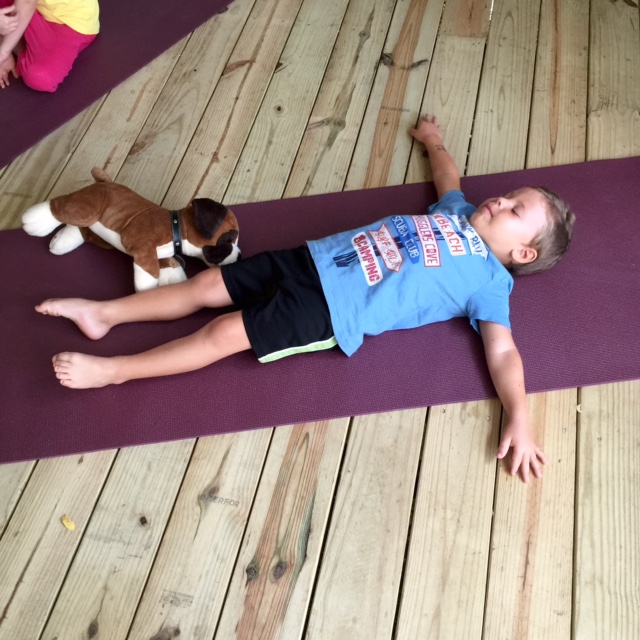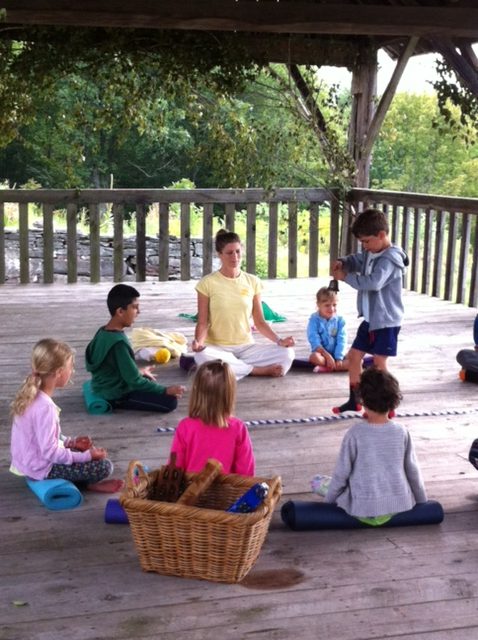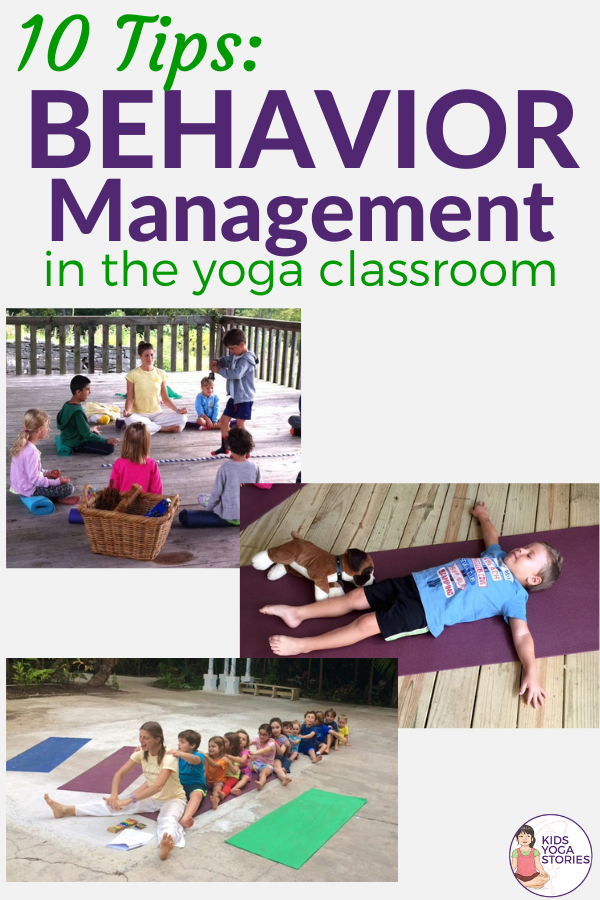Behavior Management Tips for the Yoga Classroom
Behavior management in the kids yoga class is a topic I get asked about often, so I asked the lovely Tara Rachel Jones from Flower Yoga to share some tips. Below, you’ll find ten ways that Tara Rachel works hard to create a cohesive community of yoginis who listen and respect her.
How do you inspire, educate, and engage children in your kids yoga class?
A Flower Yoga Garden of Peace:
Seeds for behavior management in the kids yoga classroom
When planting a garden, many factors have to be taken into consideration. Having a bag of seeds and some soil is a start, but only time and experience will give you the ability to create a viable and sustainable garden. When working with toddlers, children, youth, and teens, many factors must be considered. A space and yoga training is a starting point, but only time and experience give you the ability to create a viable and sustainable relationship in teaching yoga to all ages. The key is not to make the students behave, but to create a class that is both engaging and enticing to the innermost core of the body, mind, and heart.
10 Behavior Management Tips for Yoga Class
Here are 10 seeds that support a vibrant and well-managed Child/Teen Yoga Garden:
1. Know Your Inner Landscape
The first step in dealing with behavior management is you! As you mature in your own yoga practice, you discover where your “trigger buttons” are and what sets them off. Working with children and teens will humble you and allow you to become aware of your reactions to those buttons. Figure out the fundamental needs beneath your triggers so that you may effectively respond to your class and bring the class together as a whole rather than singling out one student. Building self-awareness through your own yoga practice truly informs your approach in every aspect of your teaching. When you are dealing with a behavior challenge, you will have the ability to “self-observe” your thoughts, feelings, and triggers rather than unconsciously and habitually reacting. You will have the power to shift your perspective with empathy and compassion, which will fuel your inspiration for exploring a new approach in any given situation. It will also help you remain clear about your teaching capacities and which age group you want to teach.
2. Know Child Development
Next, understand the fundamental needs that underlie habitual reactions of children at any given age. Observe various age groups and look for consistent patterns of behavior that are characterized at a particular era in human development. Meet the children/teens with activity that entices positive engagement. For example, toddlers who are restless will love to have a repetitive finger play, preschoolers enjoy movement rhymes, elementary-age children want to be challenged with balance and stamina as well as create their own movements, while tween and teens want to be acknowledged, challenged, relaxed, and inspired by wisdom.

3. Make Rules and Follow Through
You have been taught the value of rules that meet fundamental needs such as safety, respect, and community. How do you follow through? This is the challenge in classroom management. For toddlers and preschoolers, rules are part of class routine. Sing songs that include the beauty of imagination. “Today we are little birds, and our mat is the nest.” Have the children walk around the circle of mats and sing a song ending with “Fly little birds, back to the nest.” All the while, you are making your movements graceful and fun to imitate. Elementary age children can help collaborate to make rules for the class and hold them accountable for following the rules. Tell an inspiring imaginative story that highlights the values that are the core of your class. Tweens/Teens can be taught the Yamas and Nyamas and understand that these are the pillars of an upright inner character. Get them to think about each one and how it relates to an aspect of their own lives.
My rules are simple, tangible, and versatile for all ages. I use this phrase as the key ingredients to a fun class: “Look, listen, and stay together.” But instead of repeating those words over and over when the class is not focused, take a moment to observe and then respond with actions that give each rule concrete meaning.
Look: Present an action/object to the group that is WORTH looking at: a finger play, a circle game, a fun pose, a beautiful object to see and touch, or a breathing tool. (For self-reflection, write down at least three more ways to engage your group.) I bring all my presence to this purpose and entice organic interest.
Listen: Imbue your class with beautiful language, diction, and consistent cues. Be ever ready to repeat yourself as if you are saying something for the first time. Always make what you have to say sound inviting, comforting, and affirming.
Stay Together: This is a key result of looking and listening. Staying together prepares students for group games and partner poses. Introduce these activities as a treat, not a reward, but as a result of positive engagement.
4. Use Transitions as a Garland
Create consistent and meaningful transitions that become engaging signals for predictable and organized movement. The transitions in the class are the meditation spaces. Toddlers and preschoolers thrive on repetitive and consistent songs, verses, and sequences (For example, while picking up, sing a song such as, “This is the way we roll our mats…when yoga class is ending.”). When taking out props, elementary-age children can practice balancing a block on their heads to bring it to the yoga mat. Tweens/Teens need consistent inspiring direction to stay organized and focused.
5. Bring the Group into Process: Karma Yoga
Invite the children into the process of keeping the class organized. Give them tasks they can associate with routine parts of the class rhythm. For example, if you use beanbags, invite a child to pass them out. Create enough karma yoga (Seva) that everyone has a role to play in contributing to a wonderful class.

6. Maintain a Class Structure
Maintain a consistent class structure that works for you. The class structure evolves over time to reflect your experience in sharing YOUR special “magic” with the students. Your magic constitutes the aspects of your teaching that have been a success with the majority of the students you serve. You should base your class structure and routines as predictable pillars that empower the students to “own” their yoga experience and find inner sense of mastery.
7. Highlight Your Behavioral “Feng Shui”
It takes time and experience to transfer your knowledge and wisdom. The only way you will learn about behavior management is through this rite of passage, which can be amazing and difficult. Know the physical space where you are teaching. Is it big? Small? Loud? Quiet? Windows? No windows? Floor? Rug? Know the emotional and social space: Do all the children know one another? What are their ages? What are their self-regulation skills? Factors and conditions like these will have a direct effect on what happens in the class. This is where you create your magic. For example, you have a great game you learned from your training, and it fits into your sequence, but it requires large gross movement. If your group is in a small room and they struggle with personal space boundaries, alter the game and create boundaries that invoke a successful experience. If you do the game as you were taught, it might fall apart. How will you do that? Perhaps try it with children doing the gross motor movement within the yoga mat space. Oh! You are on a rug with no mats? Try making the movements slowly and gradually, building the game up over a few classes.
You have to keep imagining and motor-planning for the children in order to set up conditions for them to succeed. Your ability to do this is directly related to your knowledge and understanding of child/teen development. Your goal is discover how you can gradate the yoga experience for children so that they may function successfully in a group by always and tirelessly thinking ahead to weave a tapestry of peace.
8. Pay Attention to Details and the Value of Rituals
One beautiful way to weave a tapestry of peace in your child/teen yoga garden is to include rituals that happen at every class, something that becomes a time marker. Make the rituals something that children anticipate and participate in creating. We always play a silent bell game at the end of the class. One child per week may choose to be the one who starts the game. Elementary-age children also create a special challenge for “how” we will pass the bell to make it harder. Teens like having different challenges each class too. I have been playing the same game for over twenty years, and children are still anticipating their turn and come in talking about new, fun ways that we can pass the bell. Some children say the game is their favorite experience at yoga!

9. Collaborate
One key way to understand the group you are serving is to collect information about each child from parents and/or teachers. Be sure to create a registration form with questions that give you information about the students’ physical, social, emotional, and cognitive development. This will greatly aide your ability to plan a positive and appropriate yoga class that is sensitive to your group both collectively and individually. It is also a helpful way to discuss with parents whether or not the student needs private classes or will succeed in a group. The goal is to have our students walk away with a joy and inner mastery towards yoga. Most of all, a desire to practice again and again!
10. Respect the Experience
Every behavior situation we experience is an opportunity to discover ourselves and the students over and over again. Have the courage to remain humble and to put effort into learning other perspectives. Be respectful towards the culture, school philosophy, and social mindset of the group/school/studio, etc. If bringing the rooted traditions of yoga is not appropriate to the make-up of the class, adapt your teachings to match the students. Adjust your approach to meet them where they are. If using terminology related to traditional yoga does not fit in the situation, communicate in a way that is accessible to everyone! Accommodate to the conditions around you so that you inspire interest and engagement about growing a Yoga Garden of Peace.
Download Your Free Class Management 20 Top Tips

PIN IT FOR LATER

About the Author

Tara Rachel is a pioneer of children’s yoga in the Boston area. She has worked professionally with children since 1989. She has developed her own approach to children’s yoga, which is a simple, yet unique synthesis of education, developmental movement, and yogic teachings. Tara Rachel has been teaching yoga to young people from the ages nursery through high school since 1997. She obtained a B.A. in Early Childhood Education (N-3) from Simmons College in 1991. She became a certified Montessori Teacher in 1992. Tara Rachel was introduced to Waldorf Education in 1997 while implementing her first children’s yoga program at a Waldorf-inspired school. She completed the two-year Foundations Study Course in Waldorf Education in 2005 and now holds an M.Ed. from Antioch Graduate University in Waldorf Education. Tara Rachel teaches yoga in schools, for organizations, and at studios all around the Boston area. She also runs a teacher training course for those interested in teaching yoga to toddlers, children, youth, teens, and families at www.floweryoga.com. Tara Rachel Jones is the author of the book It’s Time for Yoga. www.littlebounderbooks.com.
FLOWER YOGA with Tara Rachel Jones, M.Ed., RCYT, RCYS
Toddler, Child, Youth, Teen, and Family Yoga
May We Suggest…







